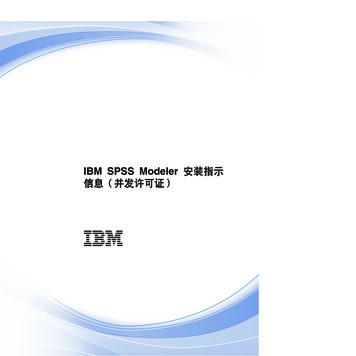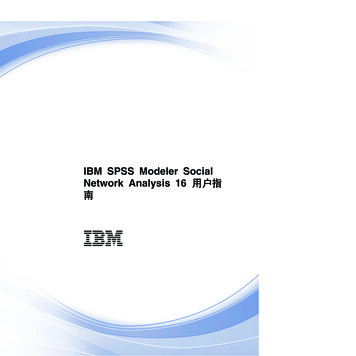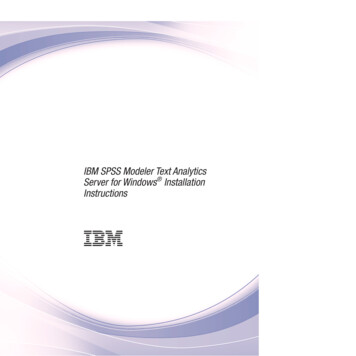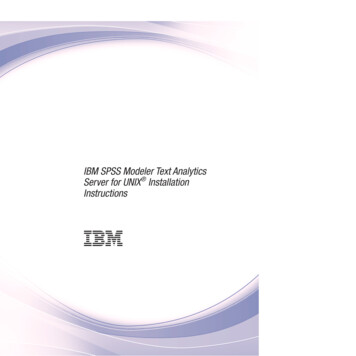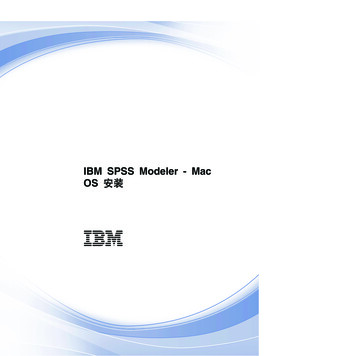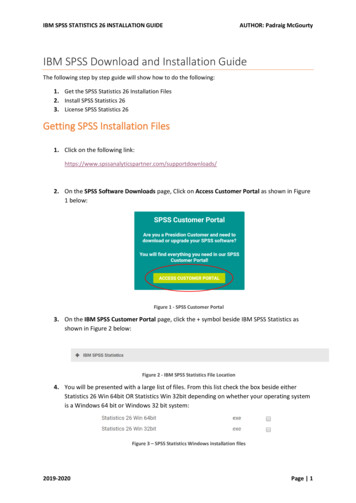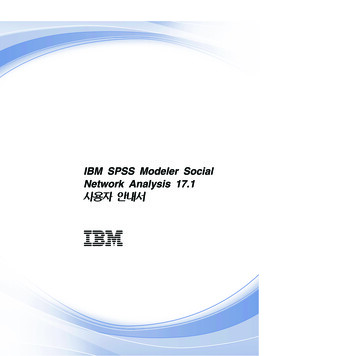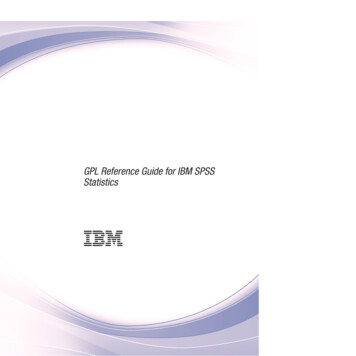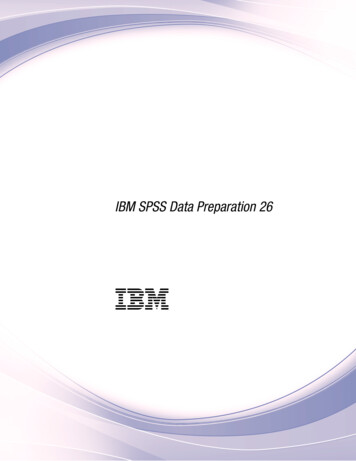
Transcription
IBM SPSS Data Preparation 26IBM
NoteBefore using this information and the product it supports, read the information in “Notices” on page 7.Product InformationThis edition applies to version 26, release 0, modification 0 of IBM SPSS Statistics and to all subsequent releasesand modifications until otherwise indicated in new editions.
ContentsData preparation . . . . . . . . . . . 1Introduction to data preparation . . . .Usage of data preparation procedures .Identify Unusual Cases . . . . . . .Identify Unusual Cases: Output . . .Identify Unusual Cases: Save . . . .Identify Unusual Cases: Missing ValuesIdentify Unusual Cases: Options . . .1113344DETECTANOMALY command additional features 5Notices . . . . . . . . . . . . . . . 7Trademarks . 9Index . . . . . . . . . . . . . . . 11iii
ivIBM SPSS Data Preparation 26
Data preparationThe following data preparation features are included in SPSS Statistics Professional Edition or the DataPreparation option.Introduction to data preparationAs computing systems increase in power, appetites for information grow proportionately, leading to moreand more data collection—more cases, more variables, and more data entry errors. These errors are thebane of the predictive model forecasts that are the ultimate goal of data warehousing, so you need tokeep the data "clean." However, the amount of data warehoused has grown so far beyond the ability toverify the cases manually that it is vital to implement automated processes for validating data.The data preparation add-on module allows you to identify unusual cases, invalid cases, variables, datavalues in your active dataset, and prepare data for modeling.Usage of data preparation proceduresYour usage of data preparation procedures depends on your particular needs. A typical route, afterloading your data, is:Metadata preparationReview the variables in your data file and determine their valid values, labels, and measurementlevels. Identify combinations of variable values that are impossible but commonly miscoded.Define validation rules based on this information. This can be a time-consuming task, but it iswell worth the effort if you need to validate data files with similar attributes on a regular basis.Data validationRun basic checks and checks against defined validation rules to identify invalid cases, variables,and data values. When invalid data are found, investigate and correct the cause. This may requireanother step through metadata preparation.Model preparationUse automated data preparation to obtain transformations of the original fields that will improvemodel building. Identify potential statistical outliers that can cause problems for many predictivemodels. Some outliers are the result of invalid variable values that have not been identified. Thismay require another step through metadata preparation.Once your data file is "clean," you are ready to build models from other add-on modules.Identify Unusual CasesThe anomaly detection procedure searches for unusual cases based on deviations from the norms of theircluster groups. The procedure is designed to quickly detect unusual cases for data-auditing purposes inthe exploratory data analysis step, prior to any inferential data analysis. This algorithm is designed forgeneric anomaly detection; that is, the definition of an anomalous case is not specific to any particularapplication, such as detection of unusual payment patterns in the healthcare industry or detection ofmoney laundering in the finance industry, in which the definition of an anomaly can be well-defined.ExampleA data analyst hired to build predictive models for stroke treatment outcomes is concerned aboutdata quality because such models can be sensitive to unusual observations. Some of theseoutlying observations represent truly unique cases and are thus unsuitable for prediction, whileother observations are caused by data entry errors in which the values are technically "correct" Copyright IBM Corporation 1989, 20191
and thus cannot be caught by data validation procedures. The Identify Unusual Cases procedurefinds and reports these outliers so that the analyst can decide how to handle them.StatisticsThe procedure produces peer groups, peer group norms for continuous and categorical variables,anomaly indices based on deviations from peer group norms, and variable impact values forvariables that most contribute to a case being considered unusual.Data considerationsData. This procedure works with both continuous and categorical variables. Each row represents adistinct observation, and each column represents a distinct variable upon which the peer groups arebased. A case identification variable can be available in the data file for marking output, but it will not beused in the analysis. Missing values are allowed. The weight variable, if specified, is ignored.The detection model can be applied to a new test data file. The elements of the test data must be thesame as the elements of the training data. And, depending on the algorithm settings, the missing valuehandling that is used to create the model may be applied to the test data file prior to scoring.Case order. Note that the solution may depend on the order of cases. To minimize order effects,randomly order the cases. To verify the stability of a given solution, you may want to obtain severaldifferent solutions with cases sorted in different random orders. In situations with extremely large filesizes, multiple runs can be performed with a sample of cases sorted in different random orders.Assumptions. The algorithm assumes that all variables are nonconstant and independent and that nocase has missing values for any of the input variables. Each continuous variable is assumed to have anormal (Gaussian) distribution, and each categorical variable is assumed to have a multinomialdistribution. Empirical internal testing indicates that the procedure is fairly robust to violations of boththe assumption of independence and the distributional assumptions, but be aware of how well theseassumptions are met.Identifying unusual cases1. From the menus choose:Data Identify Unusual Cases.2. Select at least one analysis variable.3. Optionally, choose a case identifier variable to use in labeling output.4. Click Apply.Fields with unknown measurement levelThe measurement level alert displays when the measurement level for one or more variables (fields) inthe dataset is unknown. Since measurement level affects the computation of results for this procedure, allvariables must have a defined measurement level.Scan DataReads the data in the active dataset and assigns default measurement level to any fields with acurrently unknown measurement level. If the dataset is large, that may take some time.Assign ManuallyLists all fields with an unknown measurement level. You can assign measurement level to thosefields. You can also assign measurement level in the Data Editor's Variable List pane.Since measurement level is important for this procedure, you cannot run this procedure until all fieldshave a defined measurement level.2IBM SPSS Data Preparation 26
Identify Unusual Cases: OutputThe Output dialog provides options for generating tabular output.List of unusual cases and reasons why they are considered unusualWhen selected, this option produces three tables:v The anomaly case index list displays cases that are identified as unusual and displays theircorresponding anomaly index values.v The anomaly case peer ID list displays unusual cases and information concerning theircorresponding peer groups.v The anomaly reason list displays the case number, the reason variable, the variable impactvalue, the value of the variable, and the norm of the variable for each reason.All tables are sorted by anomaly index in descending order. Moreover, the IDs of the cases aredisplayed if the case identifier variable is specified on the Variables dialog.SummariesThe controls in this group produce distribution summaries.Peer group normsThis option displays the continuous variable norms table (if any continuous variable isused in the analysis) and the categorical variable norms table (if any categorical variableis used in the analysis). The continuous variable norms table displays the mean andstandard deviation of each continuous variable for each peer group. The categoricalvariable norms table displays the mode (most popular category), frequency, andfrequency percentage of each categorical variable for each peer group. The mean of acontinuous variable and the mode of a categorical variable are used as the norm values inthe analysis.Anomaly indicesThe anomaly index summary displays descriptive statistics for the anomaly index of thecases that are identified as the most unusual.Reason occurrence by analysis variableFor each reason, the table displays the frequency and frequency percentage of eachvariable's occurrence as a reason. The table also reports the descriptive statistics of theimpact of each variable. If the maximum number of reasons is set to 0 on the Options tab,this option is not available.Cases processedThe case processing summary displays the counts and count percentages for all cases inthe active dataset, the cases included and excluded in the analysis, and the cases in eachpeer group.Identify Unusual Cases: SaveThe Save dialog provides variable and model save options.Save VariablesControls in this group allow you to save model variables to the active dataset. You can alsochoose to replace existing variables whose names conflict with the variables to be saved.Anomaly indexSaves the value of the anomaly index for each case to a variable with the specified name.Peer groupsSaves the peer group ID, case count, and size as a percentage for each case to variableswith the specified rootname. For example, if the rootname Peer is specified, the variablesPeerid, PeerSize, and PeerPctSize are generated. Peerid is the peer group ID of the case,PeerSize is the group's size, and PeerPctSize is the group's size as a percentage.Data preparation3
ReasonsSaves sets of reasoning variables with the specified rootname. A set of reasoning variablesconsists of the name of the variable as the reason, its variable impact measure, its ownvalue, and the norm value. The number of sets depends on the number of reasonsrequested on the Options tab. For example, if the rootname Reason is specified, thevariables ReasonVar k, ReasonMeasure k, ReasonValue k, and ReasonNorm k are generated,where k is the kth reason. This option is not available if the number of reasons is set to 0.Replace existing variables that have the same name or root nameWhen selected, existing variables whose names conflict with the variables to be saved arereplaced.Export Model FileAllows you to save the model to an external XML file.Identify Unusual Cases: Missing ValuesThe Missing Values dialog is used to control handling of user-missing and system-missing values.Exclude missing values from analysisCases with missing values are excluded from the analysis.Include missing values in analysisMissing values of continuous variables are substituted with their corresponding grand means,and missing categories of categorical variables are grouped and treated as a valid category. Theprocessed variables are then used in the analysis. Optionally, you can request the creation of anadditional variable that represents the proportion of missing variables in each case and use thatvariable in the analysis.Identify Unusual Cases: OptionsThe Options dialog includes settings for unusual case criteria and defining a range for the number ofpeer groups.Criteria for Identifying Unusual CasesThese following settings determine how many cases are included in the anomaly list.Percentage of cases with highest anomaly index valuesSpecify a positive number that is less than or equal to 100.Fixed number of cases with highest anomaly index valuesSpecify a positive integer that is less than or equal to the total number of cases in theactive dataset that are used in the analysis.Identify only cases whose anomaly index value meets or exceeds a minimum valueSpecify a non-negative number. A case is considered anomalous if its anomaly indexvalue is larger than or equal to the specified cutoff point. This option is used togetherwith the Percentage of cases and Fixed number of cases options. For example, if youspecify a fixed number of 50 cases and a cutoff value of 2, the anomaly list will consist of,at most, 50 cases, each with an anomaly index value that is larger than or equal to 2.Number of Peer GroupsThe procedure searches for the best number of peer groups between the specified minimum andmaximum values. The values must be positive integers, and the minimum must not exceed themaximum. When the specified values are equal, the procedure assumes a fixed number of peergroups.Note: Depending on the amount of variation in your data, there may be situations in which thenumber of peer groups that the data can support is less than the number specified as theminimum. In such a situation, the procedure may produce a smaller number of peer groups.4IBM SPSS Data Preparation 26
Maximum Number of ReasonsA reason consists of the variable impact measure, the variable name for this reason, the value ofthe variable, and the value of the corresponding peer group. Specify a non-negative integer; ifthis value equals or exceeds the number of processed variables that are used in the analysis, allvariables are shown.DETECTANOMALY command additional featuresThe command syntax language also allows you to:v Omit a few variables in the active dataset from analysis without explicitly specifying all of the analysisvariables (using the EXCEPT subcommand).v Specify an adjustment to balance the influence of continuous and categorical variables (using theMLWEIGHT keyword on the CRITERIA subcommand).See the Command Syntax Reference for complete syntax information.Data preparation5
6IBM SPSS Data Preparation 26
NoticesThis information was developed for products and services offered in the US. This material might beavailable from IBM in other languages. However, you may be required to own a copy of the product orproduct version in that language in order to access it.IBM may not offer the products, services, or features discussed in this document in other countries.Consult your local IBM representative for information on the products and services currently available inyour area. Any reference to an IBM product, program, or service is not intended to state or imply thatonly that IBM product, program, or service may be used. Any functionally equivalent product, program,or service that does not infringe any IBM intellectual property right may be used instead. However, it isthe user's responsibility to evaluate and verify the operation of any non-IBM product, program, orservice.IBM may have patents or pending patent applications covering subject matter described in thisdocument. The furnishing of this document does not grant you any license to these patents. You can sendlicense inquiries, in writing, to:IBM Director of LicensingIBM CorporationNorth Castle Drive, MD-NC119Armonk, NY 10504-1785USFor license inquiries regarding double-byte (DBCS) information, contact the IBM Intellectual PropertyDepartment in your country or send inquiries, in writing, to:Intellectual Property LicensingLegal and Intellectual Property LawIBM Japan Ltd.19-21, Nihonbashi-Hakozakicho, Chuo-kuTokyo 103-8510, JapanINTERNATIONAL BUSINESS MACHINES CORPORATION PROVIDES THIS PUBLICATION "AS IS"WITHOUT WARRANTY OF ANY KIND, EITHER EXPRESS OR IMPLIED, INCLUDING, BUT NOTLIMITED TO, THE IMPLIED WARRANTIES OF NON-INFRINGEMENT, MERCHANTABILITY ORFITNESS FOR A PARTICULAR PURPOSE. Some jurisdictions do not allow disclaimer of express orimplied warranties in certain transactions, therefore, this statement may not apply to you.This information could include technical inaccuracies or typographical errors. Changes are periodicallymade to the information herein; these changes will be incorporated in new editions of the publication.IBM may make improvements and/or changes in the product(s) and/or the program(s) described in thispublication at any time without notice.Any references in this information to non-IBM websites are provided for convenience only and do not inany manner serve as an endorsement of those websites. The materials at those websites are not part ofthe materials for this IBM product and use of those websites is at your own risk.IBM may use or distribute any of the information you provide in any way it believes appropriate withoutincurring any obligation to you.7
Licensees of this program who wish to have information about it for the purpose of enabling: (i) theexchange of information between independently created programs and other programs (including thisone) and (ii) the mutual use of the information which has been exchanged, should contact:IBM Director of LicensingIBM CorporationNorth Castle Drive, MD-NC119Armonk, NY 10504-1785USSuch information may be available, subject to appropriate terms and conditions, including in some cases,payment of a fee.The licensed program described in this document and all licensed material available for it are providedby IBM under terms of the IBM Customer Agreement, IBM International Program License Agreement orany equivalent agreement between us.The performance data and client examples cited are presented for illustrative purposes only. Actualperformance results may vary depending on specific configurations and operating conditions.Information concerning non-IBM products was obtained from the suppliers of those products, theirpublished announcements or other publicly available sources. IBM has not tested those products andcannot confirm the accuracy of performance, compatibility or any other claims related tonon-IBMproducts. Questions on the capabilities of non-IBM products should be addressed to thesuppliers of those products.Statements regarding IBM's future direction or intent are subject to change or withdrawal without notice,and represent goals and objectives only.This information contains examples of data and reports used in daily business operations. To illustratethem as completely as possible, the examples include the names of individuals, companies, brands, andproducts. All of these names are fictitious and any similarity to actual people or business enterprises isentirely coincidental.COPYRIGHT LICENSE:This information contains sample application programs in source language, which illustrate programmingtechniques on various operating platforms. You may copy, modify, and distribute these sample programsin any form without payment to IBM, for the purposes of developing, using, marketing or distributingapplication programs conforming to the application programming interface for the operating platform forwhich the sample programs are written. These examples have not been thoroughly tested under allconditions. IBM, therefore, cannot guarantee or imply reliability, serviceability, or function of theseprograms. The sample programs are provided "AS IS", without warranty of any kind. IBM shall not beliable for any damages arising out of your use of the sample programs.Each copy or any portion of these sample programs or any derivative work, must include a copyrightnotice as follows: IBM 2019. Portions of this code are derived from IBM Corp. Sample Programs. Copyright IBM Corp. 1989 - 20019. All rights reserved.8IBM SPSS Data Preparation 26
TrademarksIBM, the IBM logo, and ibm.com are trademarks or registered trademarks of International BusinessMachines Corp., registered in many jurisdictions worldwide. Other product and service names might betrademarks of IBM or other companies. A current list of IBM trademarks is available on the web at"Copyright and trademark information" at www.ibm.com/legal/copytrade.shtml.Adobe, the Adobe logo, PostScript, and the PostScript logo are either registered trademarks or trademarksof Adobe Systems Incorporated in the United States, and/or other countries.Intel, Intel logo, Intel Inside, Intel Inside logo, Intel Centrino, Intel Centrino logo, Celeron, Intel Xeon,Intel SpeedStep, Itanium, and Pentium are trademarks or registered trademarks of Intel Corporation or itssubsidiaries in the United States and other countries.Linux is a registered trademark of Linus Torvalds in the United States, other countries, or both.Microsoft, Windows, Windows NT, and the Windows logo are trademarks of Microsoft Corporation in theUnited States, other countries, or both.UNIX is a registered trademark of The Open Group in the United States and other countries.Java and all Java-based trademarks and logos are trademarks or registered trademarks of Oracle and/orits affiliates.Notices9
10IBM SPSS Data Preparation 26
IndexAanomaly indicesin Identify Unusual Cases3IIdentify Unusual Cases 1export model file 3missing values 4options 4output 3save variables 3Mmissing valuesin Identify Unusual Cases4Ppeer groupsin Identify Unusual Cases3Rreasonsin Identify Unusual Cases311
12IBM SPSS Data Preparation 26
IBM Printed in USA
and mor e data collection—mor e cases, mor e variables, and mor e data entry err ors. These err ors ar e the bane of the pr edictive model for ecasts that ar e the ultimate goal of data war ehousing, so you need to keep the data "clean." However , the amount of data war ehoused has gr own so far beyond the ability to verify the cases manually that it is vital to implement automated pr .
